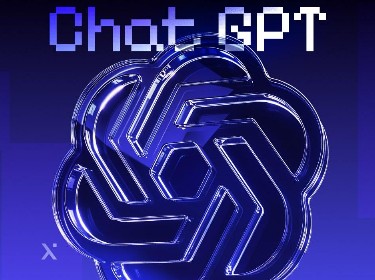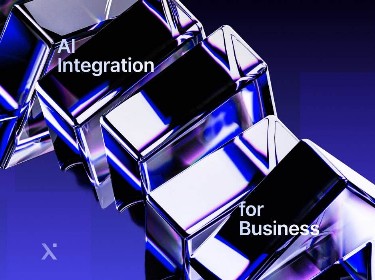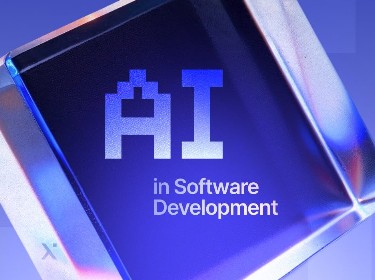2023 will definitely be remembered as the year when generative AI applications went viral by producing content that is almost indistinguishable from that made by a human. But how does the technology really work?
It was next to impossible to miss all the generative AI development hype suddenly sweeping the internet in late 2022 and early 2023. Eye-catching images from Midjourney and witty posts composed by ChatGPT literally flooded our social media feeds.
The generative AI market is projected to grow to $30.4 billion by 2028, three times the value registered in 2022.
Since the technology keeps evolving and shows impressive results, it has great potential to help businesses enhance and streamline their processes.
Read on to find out how our generative AI consulting company works, what its benefits and limitations are, and how businesses can leverage this technology. We also prepared an overview of the top generative AI solutions.
Find out what machine learning techniques are out there
This article is part of our larger series dedicated to Generative AI. To explore this topic in greater detail, here’s the list of articles we recommend:
Generative AI Market Map: From History and State to Trends and Applications [With Infographic]
Exploring Key Generative AI Applications and Use Cases across Industries
What is generative AI?
Generative artificial intelligence (AI) is a technology that can create new content, including images, texts, audio, video, and code based on a description given by a user.
According to Gartner, 10% of all data produced will come from generative AI in 2025.
Experts say that generative AI use cases will go beyond creative work and expand to such fields as medicine production and manufacturing.
“Early foundation models like ChatGPT focus on the ability of generative AI to augment creative work, but by 2025, we expect more than 30% — up from zero today — of new drugs and materials to be systematically discovered using generative AI techniques,” — Brian Burke, Research VP for Technology Innovation at Gartner.
How does generative AI work?
To produce new content, generative AI uses a prompt directing what exact output a user wants to get. It can be a text instruction, an image, a video, or any format a generative solution is able to process.
Under the hood, an AI model generates new content based on the patterns it has learned from the dataset it was trained on.
Generative AI models usually go through unsupervised or semi-supervised learning, and train on massive volumes of data. For example, the most popular generative AI chatbot, ChatGPT, used 570 GB of training data or 300 billion words collected all over the internet.
What are the leading examples of generative AI solutions?
![]()
To give you a better understanding of what generative AI tools are capable of, we’ve collected top five trending solutions producing different types of content. These are ChatGPT, Midjourney, Bicasso, CharacterGPT, and Pictory.
Let’s examine these solutions in greater detail.
ChatGPT
ChatGPT is a language generation model able to create all kinds of texts, from simple sentences to entire articles and essays. It is now considered the fastest-growing app ever, taking only five days to reach 1 million users. For businesses, this technology becomes even more powerful when professionally incorporated into their own software through specialized GPT integration services.
To start interacting with ChatGPT, a user can ask it a question or come up with a direct guideline, such as: “Compose a title for a gothic book”.
The tool can translate to over 100 languages, including rare ones like Zulu and Wolof. ChatGPT also knows how to write code in Python, Java, JavaScript, C++, Ruby, Swift, and other programming languages. So you can literally ask the chatbot to write an app from scratch.
You can also use the solution to have a chat. It is able to keep track of the conversation and remembers information mentioned earlier.
Midjourney
Midjourney is a generative AI bot that creates images based on text prompts or other pictures.
A prompt can be a brief description or a detailed instruction specifying artistic styles, mood, and techniques. Meanwhile, to get an illustration inspired by some other image, you just need to add a link to it.
Midjourney generates four variations of the image so users can choose the one they like most.
With each new iteration, the solution greatly improves the quality of its output, releasing highly realistic images. It’s come so far that Midjourney created pictures of Donald Trump being arrested which looked so natural that some people believed they were original.
Bicasso
Developed by Binance, Bicasso is a generative AI model that produces NFT profile pictures based on descriptions and images provided by users. The solution creates four pictures and you can decide which one will be minted as a free NFT on the BNB Chain.
The Bicasso beta version was released on March 1, 2023, with the maximum number of mints set at 10,000. The limit was reached in just 2.5 hours.
Take a look at CheckNFT.iO — an AI-powered solution for NFT analysis
CharacterGPT
CharacterGPT is an AI tool that makes it possible to create unique characters and customize their appearance, voice, and personality. You just need to come up with a text description.
These characters can then be minted on the Polygon blockchain and trained to fulfill specific functions across AI-compatible platforms. They can be digital twins of real people, virtual assistants, non-player characters, and more.
With regard to their interactivity, CharacterGPT’s tokens are called iNFTs — an abbreviation of intelligent non-fungible tokens. An expert NFT development services team can help you implement the app with the same functionality easily.
Pictory
Pictory is a generative AI solution allowing users to effortlessly create and edit videos. You just need to upload a script and let Pictory select suitable background music and visuals from its extensive library. Then, you can choose to upgrade the draft by, for example, adding a voice-over or changing some visuals.
As well as pre-made scripts, it is possible to share a URL of a blog article or post. In this case, Pictory singles out the most relevant points and suggests its own script which can then be turned into a video.
The solution also makes it possible to edit existing videos. All you need to do is upload a recording and Pictory will make a transcription. You can then delete parts of the original video by removing the text. The tool can also analyze the transcript and point out the highlights.
What are the benefits of generative AI?
![]()
Now that we are acquainted with the top generative solutions and the awesome functions they can perform, here is a short summary of the benefits the technology offers to businesses:
- Tasks automation — generative AI solutions are able to perform different tasks faster than humans since they can run through terabytes of data in their knowledge base in a matter of minutes or even seconds.
- Cost saving — since some processes can be automated, companies can reduce labor costs and expenses on specific software and hardware.
- Enhanced decision making — collecting and analyzing data about different processes within a specific industry and market can be quite overwhelming and time-consuming for a human brain. However, AI models can run through massive amounts of data really fast, extracting valuable insights and patterns.
- Effortless content improvement — a generative AI solution can enhance the quality of existing pieces of content. For example, it can add features that will appeal more to the intended audience.
- Fast content repurposing — generative AI makes it very easy to transform your content into other forms. A blog article, say, can be turned into a social media post or a video.
What are the downsides of generative AI?
![]()
Every technology has its weak spots and generative AI is no exception. Here are its downsides:
- Limited knowledge
Even though it may feel like generative AI solutions can perform any task to a very proficient level, we should remember that their knowledge is limited by the training set. Thus, the output may be incomplete, confusing, or, in some cases, completely wrong. For example, ChatGPT is only aware of events that occurred up until September 2021, and can’t update its knowledge base in real time.
- Bias
Sometimes generative AI applications produce biased output. It mostly happens due to an irrelevant or ill-balanced training dataset and leads to wrong and discriminatory results. Such a situation happened to Lensa, an image-producing tool, whose users noticed that the solution oversexualizes women by transforming their body parameters and underrepresents people of color by not being able to capture their facial features correctly.
- Errors
Generative AI modules make mistakes due to factors such as erroneous, incomplete, or outdated training data. Google’s AI chatbot Bard ended up in such a position when users noticed a mistake right in its demo video.
- Copyright infringement
Since training data for ML modules is collected all over the internet, it definitely includes content protected by copyright. This causes frustration amongst content creators and leads to legal claims against generative AI tools. The most recent example is a collective lawsuit of artists against the Midjorney and Stable Diffusion image generators.
- Risk of lay-offs
Many specialists are afraid that generative AI solutions will replace them in the workplace, since their performance is faster and not limited by working hours.
How can your business leverage generative AI?
Depending on your business specification and industry, the possible applications of generative AI will differ. Let’s take a look at some use cases across four different departments:
Marketing: content idea generation and content creation, content plan preparation, content repurposing, research, translation.
Sales: personalized email and video creation, customer data analysis, virtual assistants.
Software engineering: code generation, completion, review, and bug fixing.
Human resources: job market research, job descriptions, requirements specifications, and interview question creation.
What to consider before introducing generative AI to your business processes
To integrate generative AI effectively, we recommend you first consider the following questions:
- What will the process of implementing AI solutions look like?
To ensure your employees understand the benefits the new technology offers and know how to apply it in their work, you will need to hold training sessions, presentations, or workshops. You may also find it necessary to hire AI specialists.
- How much money will the introduction of the technology require?
Prices for generative solutions of different types and subscription policy differ, so you will need to determine what exact tools your company needs and whether they are worth spending the money on.
- How will you assess the quality of AI generated content?
As previously mentioned, generative AI output is not perfect, so you need to specify who will be responsible for quality assessment and how improvements will be made.
- How will you ensure the safety of your corporate data?
Generative AI applications train as you use them, adding the new data into its knowledge base, so you need to provide guidelines preventing leakage of sensitive business data.
Getting insightful and accurate answers to these questions requires thorough research of the whole business model and its processes, so we recommend seeking professional advice from an experienced AI chatbot development company.
Conclusion
Generative AI really is a disruptive technology, and it’s already altering the way we produce content across various domains: entertainment, education, marketing, and even software engineering.
When implemented and leveraged right, the technology is very beneficial, allowing specialists to switch from mundane repetitive tasks to creative ones, boosting productivity and engagement. However, there are still challenges to be addressed, such as biased output and ethical concerns.
Organizations wishing to leverage generative AI should, therefore, clearly understand its benefits and limitations, and carefully consider how the technology will enhance their specific business processes.
PixelPlex is a generative AI integration company that will gladly assist you with implementing generative AI into your company’s workflow, so feel free to get in touch with us.




